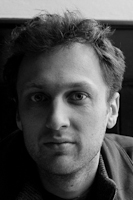Thesis Title
Contemplative attention to moving images. Profanations of the sacred in film and video.
(completed in 2017)
Abstract
Throughout the course of the history of art, debates whether the image can have the power and depth of the sacred are recurrent in almost every tradition and time-period. In fact, an argument can be made that images ontologically are an instance of the sacred, as they have the potential to evoke presence. This study aims to address questions of the sacred in images both as a philosophical and as a medial question, ultimately aiming to specifically deal with moving images both in film and video (since they are increasingly seen as a replacement or an expansion of more traditional media of art such as painting and sculpture). Oscillating between philosophical phenomenology on the one hand, and theories of an embodied experience of visuality both in a liturgical and in a cinematic context, I aim to address this compelling question that moved many artists and filmmakers: Beyond any religious narrative or representation, what aesthetical and/or materialist qualities are responsible for the evocation of depth of the sacred in moving images?
This question lies at the very basis of the work of the Russian filmmaker Andrei Tarkovsky, and touches upon issues at stake in the work of Robert Bresson, Carl Dreyer and Pier Paolo Pasolini, followed by more contemporary filmmakers such as Bruno Dumont, Nuri Bilge Ceylan, Bela Tarr and Carlos Reygadas. However, it is my claim that the sacred can act most pertinently as a critical concept to address moving images in the context of artist films and video installations today. Not only due to its attention to specific spatiality, but also for its intrinsic cinematographic potential, the artist’s moving image increasingly offers an occasion for contemplative visuality and even visual devotion. Ranging over the work of experimental filmmakers such as Nathaniel Dorsky, Bill Viola, Ben Rivers and visual artists such as David Claerbout, Marcel Broodthaers, Marine Hugonnier and many others, this study intends to both develop a philosophical framework for understanding sacred visuality today as well as to propagate the concept of the sacred as a critical tool for understanding contemporary image culture.


